Understanding Winnipeg’s Unemployment Rate: Trends, Challenges, and Forecasts
Key Insights
| Statistics Canada reveals that the unemployment rate for Winnipeg rose 0.3 points in December 2024 from November 2024, an increase of 5.1%. According to a report by Statistics Canada, Manitoba maintains a lower-than-average unemployment rate of 5.1%, compared to the national level of 6.1%. The Manitoba Labor Market Outlook identifies that there was an improvement in the sectors of accommodation and food services, which employed 5,500 people – an improvement of 25.2%. Information provided by the Government of Manitoba shows how unemployment among youths (15-24 years) improved from 11.4% in August to 10.6% in September of 2024, which is a 7% decrease. The Manitoba Labour Market Outlook forecasts that from 2022 to 2026, Manitoba’s working-age population will grow from 1,137,100 to 1,181,815, adding over 44,700 potential workers to the labor force. |
A report by Statistics Canada showed that Winnipeg’s unemployment rate increased by 0.3 percentage points from November to December 2024, a 5.1% increase from the previous month.
This represents a slowdown in employment growth but remains in line with the city’s 10-year average of 6.0%.
Meanwhile, there was a net loss of 200 jobs in December 2024, primarily due to a 10.5% decline in part-time employment, as 2,200 part-time jobs vanished. Full-time employment, on the other hand, grew by 2,000 jobs, which is a 1.4% increase.
The table below illustrates employment performance by sector.
| Metric | December 2024 | November 2024 | Monthly Change | Percentage Change | Yearly Change |
| Unemployment Rate | 6.2% | 5.9% | +0.3 ppt | +5.1% | – |
| Full-Time Jobs | +2,000 | +1,500 | +500 | +1.4% | +15,000 |
| Part-Time Jobs | -2,200 | -900 | -1,300 | -10.5% | – |
| Net Employment Change | -200 | +600 | -800 | -0.1% | – |
| Transportation & Warehousing | +5,000 | – | – | +3.2% | +5,000 |
| Healthcare | +4,000 | – | – | +2.8% | +4,000 |
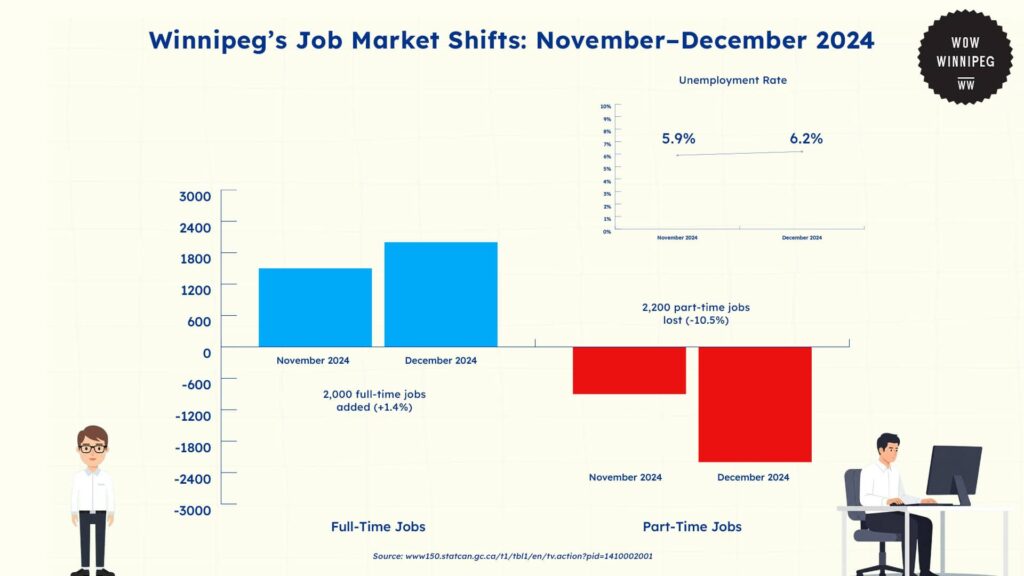
Winnipeg’s labour market reported conflicting patterns during December, with expansion in full-time employment (+2,000, or 1.4%) countered by a considerable decline in part-time employment (-2,200, or 10.5%).
This net loss in employment of 200 jobs resulted in the 0.3 percentage point increase in unemployment.
Transportation and warehousing industries contributed 5,000 jobs (+3.2%), which was a sign of high demand in the logistics industry.
Meanwhile, healthcare jobs increased by 4,000 positions (+2.8%), which was fueled by growing demands in medical and elder care services.
Looking ahead, Manitoba’s labor market is expected to expand, with 114,300 job openings projected by 2026.
Regional Analysis of Unemployment Throughout Canada
Data from Statistics Canada reveals that unemployment rates in Canada in April 2024 revealed significant regional variations. Generally, the national unemployment rate was 6.1%, which remained the same as the previous month.
Manitoba’s unemployment rate rose to 5.1%, marking a 0.1 percentage point increase from March. Despite this, Manitoba still maintains a lower-than-average unemployment rate compared to the national level of 6.1%.
Newfoundland and Labrador had the highest unemployment rate at 9.1%, even though it decreased by 1.0 percentage point from March.
In contrast, Yukon had the lowest level of unemployment at 3.1%, even though it slipped by 1.2 percentage points.
Other provinces experienced increases in unemployment, though minor. These include Alberta (+0.7 ppt to 7.0%), Saskatchewan (+0.3 ppt to 5.7%), and Ontario (+0.1 ppt to 6.8%).
| Region | Unemployment Rate (%) | Monthly Change (ppt) |
| Canada | 6.1% | 0.0 |
| Newfoundland and Labrador | 9.1% | -1.0 |
| Nova Scotia | 6.1% | -0.1 |
| New Brunswick | 7.0% | -0.8 |
| Quebec | 5.1% | +0.1 |
| Ontario | 6.8% | +0.1 |
| Manitoba | 5.1% | +0.1 |
| Saskatchewan | 5.7% | +0.3 |
| Alberta | 7.0% | +0.7 |
| British Columbia | 5.0% | -0.5 |
| Yukon | 3.1% | -1.2 |
| Northwest Territories | 5.5% | +0.5 |
| Nunavut | 8.5% | -0.2 |
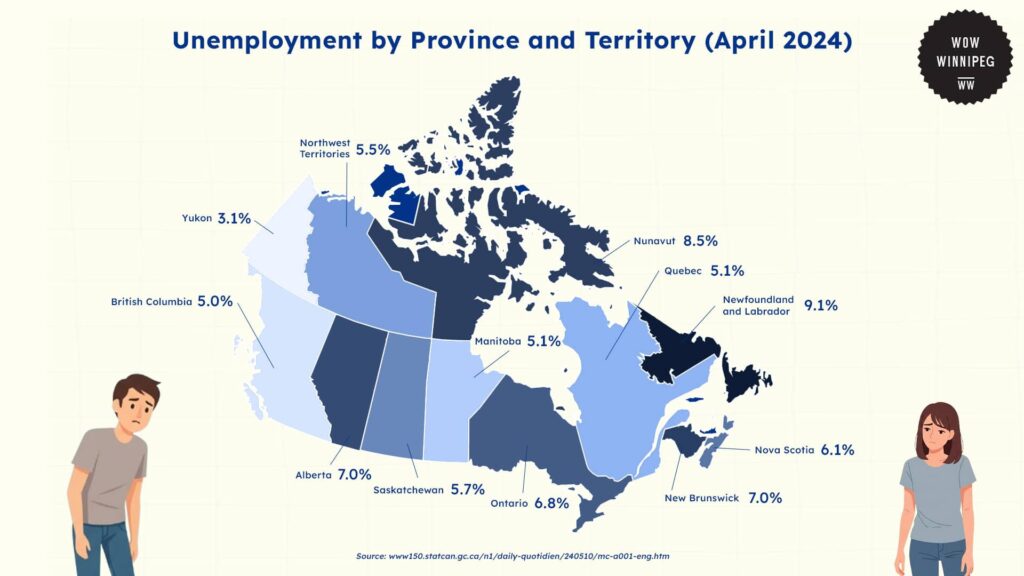
Though Manitoba’s 5.1% unemployment rate remains a percentage point below the national average, its 0.1 percentage point increase indicates a slight moderation of its labor market.
The province has traditionally enjoyed stable employment levels due to a diversified economy across agriculture, manufacturing, and services.
City-Level Unemployment Trends in Winnipeg
The Manitoba Labor Market Outlook reveals that Winnipeg’s labor market showed evidence of growth and contraction in various industries during December 2024.
| Industry | Employment Change | Percentage Change |
| Accommodation & Food Services | +5,500 | +25.2% |
| Construction | +3,200 | +12.7% |
| Healthcare | +4,000 | +10.5% |
| Transportation & Warehousing | +5,000 | – |
| Manufacturing | -2,300 | -5.1% |
| Public Administration | -4,400 | -14.1% |
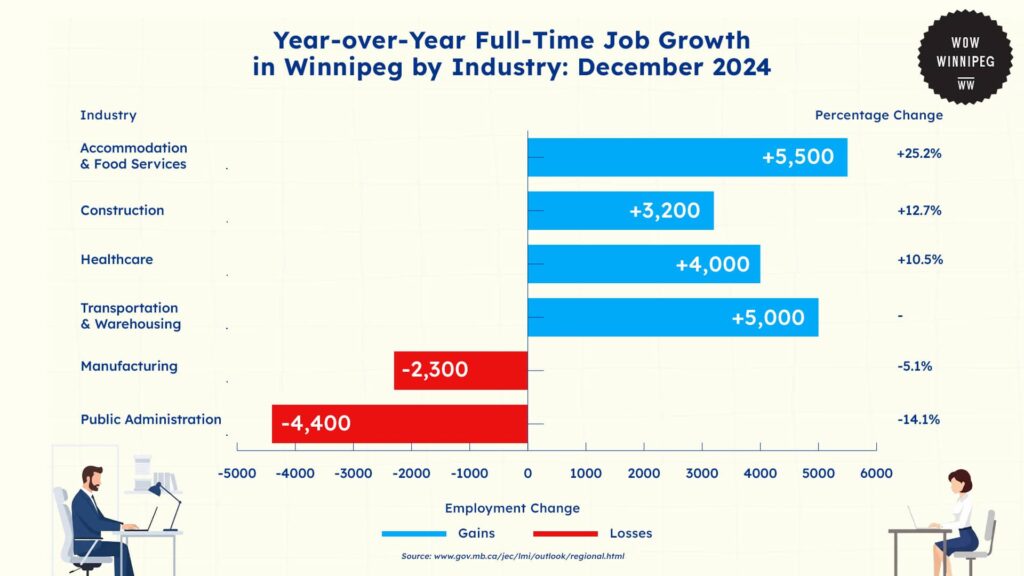
There were notable job gains in certain industries, such as accommodation and food services, which created 5,500 jobs, showing a 25.2% gain. Much of this increase was due to strong consumer demand and ongoing tourism recovery.
Construction also saw significant increases, with employment increasing by 3,200 jobs, up 12.7%. This was driven by continued infrastructure work and higher development activity.
Similarly, healthcare employment increased by 4,000 jobs, growing 10.5% as the need for medical and elder care services continued to grow in tandem with population growth.
Meanwhile, the warehousing and transport industry created 5,000 jobs, responding to growth in demand for distribution and logistics services.
However, not all sectors showed the same growth. Public administration saw a steep decline, losing 4,400 jobs, a 14.1% decline.
Manufacturing also fared poorly, losing 2,300 jobs, a 5.1% decline, indicating continuing weakness in industrial production and supply chain glitches.
Demographic Breakdown of Unemployment Rates in Winnipeg
Data from the Government of Manitoba reveals how certain demographics are disproportionately affected by unemployment in Winnipeg.
Unemployment Trends by Age
Age remains a determining factor in employment gaps, with young workers experiencing much higher unemployment rates than older workers.
Youth unemployment (15–24 years) decreased from 11.4% in August to 10.6% in September, a 7% improvement.
At the same time, adult unemployment of workers 25 and older was also stable at 4.8%, which shows that the labor market for older workers is stable.
The stability in adult unemployment implies that the demand for skilled labor is constant with less volatility than among younger workers.
| Age Group | August 2024 | September 2024 | Percentage Change |
| Youth (15–24) | 11.4% | 10.6% | -7.0% |
| Adults (25+) | 4.8% | 4.8% | 0.0% |
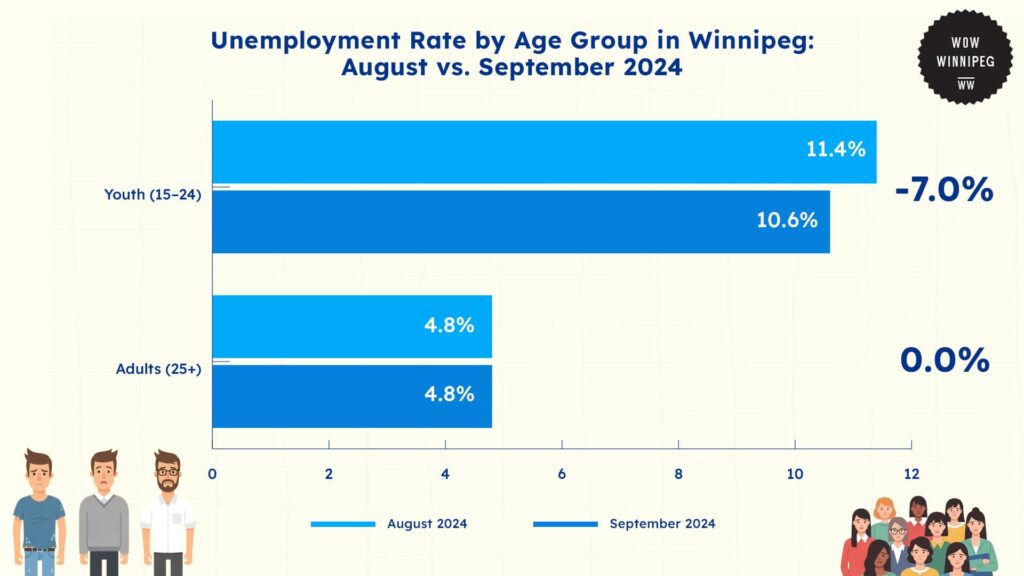
Unemployment Trends by Gender
Female unemployment declined slightly from 5.6% in August 2024 to 5.5% in September, signaling a 1.8% improvement in job availability for women.
Meanwhile, male unemployment decreased from 6.0% to 5.9%, reflecting a modest 1.7% decline.
The statistics indicate that female workers had a slightly improved job market recovery than men, as employment opportunities for them rose by 1.4%.
On the other hand, the employment opportunity improved by a much lower 0.1% for men, suggesting a slow rate of job gains for males.
| Gender | August 2024 | September 2024 | Percentage Change |
| Female | 5.6% | 5.5% | -1.8% |
| Male | 6.0% | 5.9% | -1.7% |
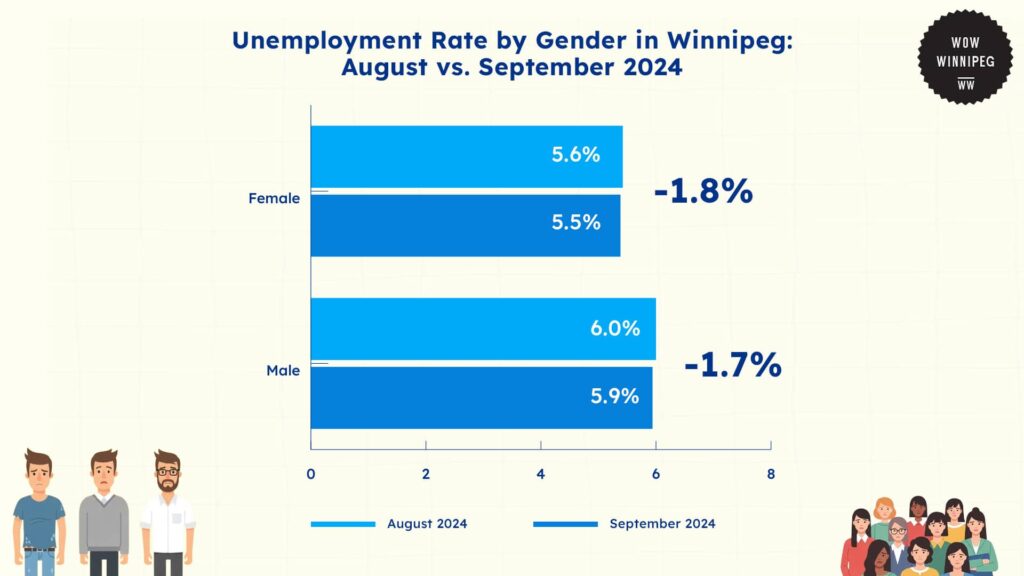
Costs and Consequences of Unemployment in Winnipeg
Economic Costs and Consequences
The Manitoba Labour Market Outlook predicts that between 2022 and 2026, Manitoba’s working-age population will increase from 1,137,100 to 1,181,815, adding more than 44,700 potential laborers to the workforce.
However, retirements, interprovincial migration, and workforce exits will create job vacancies that must be filled to sustain economic stability.
The province anticipates 66,300 retirements and a net loss of 24,000 workers through interprovincial migration, which could put pressure on some industries if labor shortages continue.
Moreover, the unemployment rate is predicted to be between.⅘% and 4.6% in 2026, indicating a relatively stable but slightly tightening labor market.
Levels of employment are predicted to rise from 672,357 in 2022 to 690,233 in 2026, indicating slow but consistent workforce growth.
Social Costs and Consequences
Increased unemployment in Winnipeg has long-term social implications, especially for younger employees and vulnerable populations. Unemployment can lead to greater financial instability, compelling individuals to turn to social welfare programs.
Additionally, some sectors could face skills mismatches, with vacancies calling for qualifications that jobless workers lack.
The province puts the figure of job vacancies over the next five years at 56%, calling for post-secondary training. Thus, education and labor market development are important to mitigate unemployment risks.
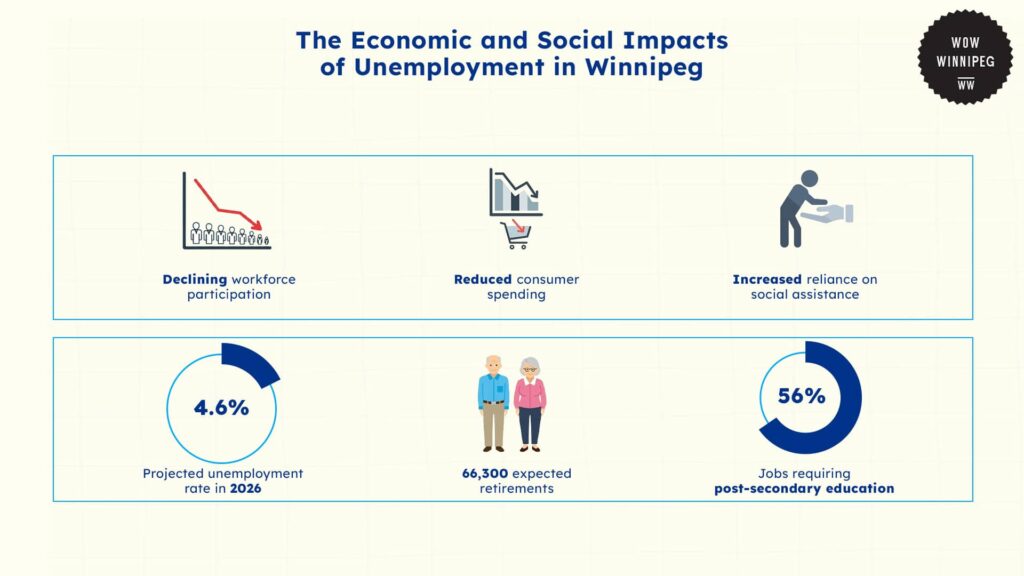
Interventions and Solutions to Unemployment in Winnipeg
The Government of Winnipeg provides various employment support services that seek to reduce unemployment by providing job seekers with skills, training, and connections to secure stable employment.
Opportunities for Employment (OFE) offers free job search support, resume preparation, and short-term training sessions specifically designed to address employer requirements so that individuals can move into long-term employment.
For younger populations, the Youth Employment Services (YES) targets the 16- to 29-year-olds with job readiness programs, skills training workshops, and networking sessions to assist young workers in gaining entry into the workforce.
For individuals facing barriers to employment due to disabilities or health conditions, Reaching E-Quality Employment Services (REES) offers personalized support, job referrals, and workplace accommodations to ensure long-term job retention.
Meanwhile, Economic Development Winnipeg’s Talent & Workforce Development unit collaborates directly with companies to solve labor shortages, develop hiring strategies, and match employers with qualified workers, including foreign talent, through initiatives such as the Global Talent Stream.
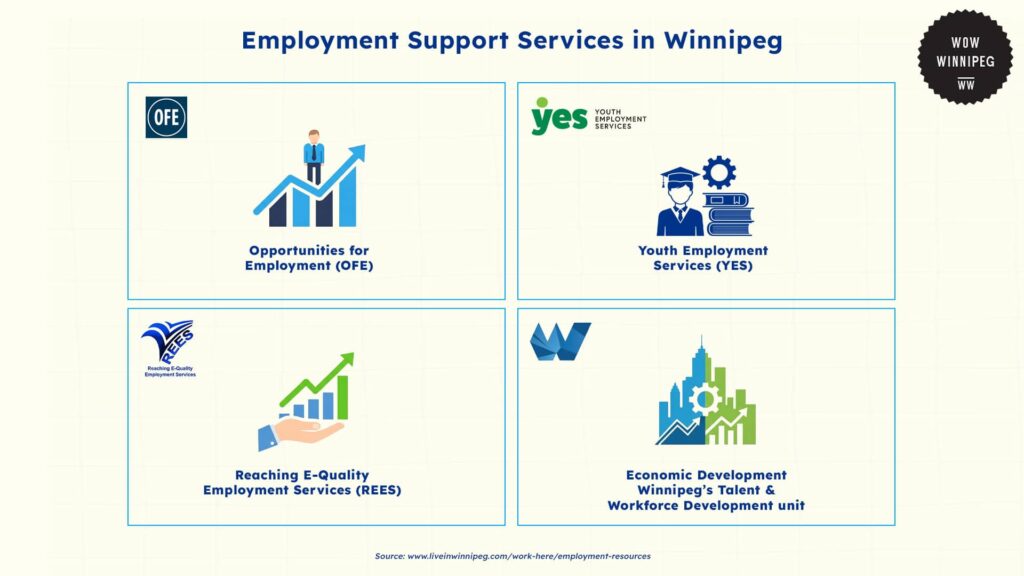
The Future of Unemployment in Winnipeg
Winnipeg’s labour market will grow steadily over the next few years based on population growth, retirements, and changing industry needs.
The Manitoba Labour Market Outlook for 2022–2026 suggests the province will experience 114,300 job openings over this time, with 36,200 new jobs resulting from economic growth and 78,100 jobs opening due to retirements and workforce turnover.
As the number of working-age individuals grows from 1,137,100 in 2022 to 1,181,815 by 2026, the level of employment is also likely to increase.
Industry forecasts project that healthcare and social assistance, wholesale and retail trade, and education will share a substantial share of new employment opportunities.
Winnipeg’s labor market will also be influenced by migration patterns. Manitoba will be gaining 80,789 new residents through immigration by 2026, but interprovincial migration will lead to a net loss of 45,880 employees as people move elsewhere in Canada.
This migration highlights the need to attract and retain skilled workers to fill increasing job market needs.
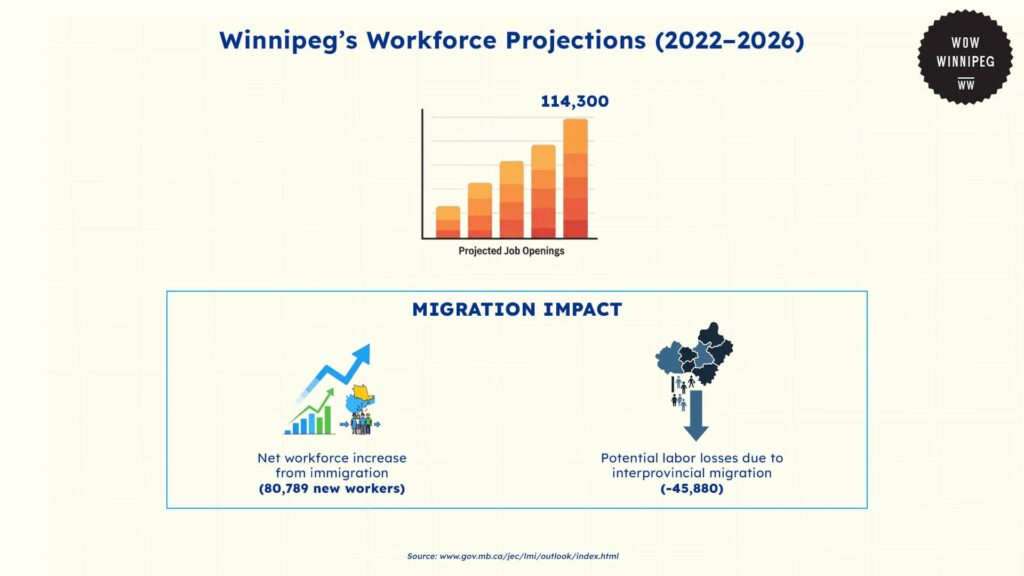
References
- Statistics Canada. (n.d.). Labour force characteristics by province, monthly, seasonally adjusted and trend-cycle, last 5 months (1410002001). Retrieved from https://www150.statcan.gc.ca/t1/tbl1/en/tv.action?pid=1410002001
- Statistics Canada. (2024, May 10). Labour market conditions in Canada – April 2024. The Daily. Retrieved from https://www150.statcan.gc.ca/n1/daily-quotidien/240510/mc-a001-eng.htm
- Government of Manitoba. (n.d.). Regional labour market outlook. Manitoba Jobs and Economy. Retrieved from https://www.gov.mb.ca/jec/lmi/outlook/regional.html
- Government of Manitoba. (2024, September). Labour force survey bulletin – September 2024. Manitoba Bureau of Statistics. Retrieved from https://www.gov.mb.ca/mbs/publications/mbs203_lfs_bulletin_2024_m09.pdf
- Government of Manitoba. (n.d.). Manitoba labour market outlook 2022–2026. Manitoba Jobs and Economy. Retrieved from https://www.gov.mb.ca/jec/lmi/outlook/index.html
- Economic Development Winnipeg. (n.d.). Employment resources. Live in Winnipeg. Retrieved from https://www.liveinwinnipeg.com/work-here/employment-resources
- Opportunities for Employment. (n.d.). Opportunities for Employment (OFE). Retrieved from https://www.ofe.ca/
- Youth Employment Services Manitoba. (n.d.). Youth Employment Services (YES). Retrieved from https://yesmb.ca/


